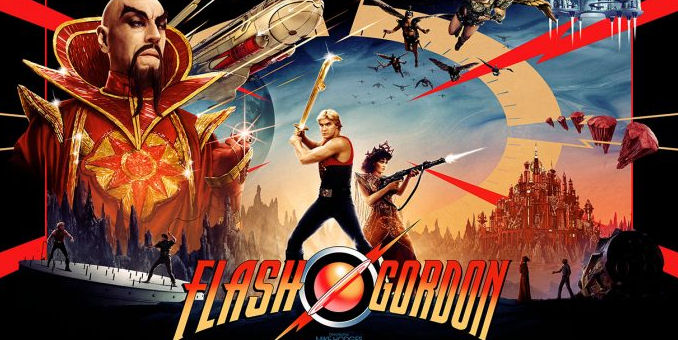
In memory of Flash Gordon director Mike Hodges, who passed away earlier this week, we are rerunning our critical appreciation of his 1980 science-fiction cult classic.
 There are many films out there that have probably been unfairly lambasted by either critics or the passage of time. For me, one of those films is the 1980 Dino De Laurentiis produced comic-strip adaptation Flash Gordon. A garish collision of primary colors, art deco design and good old-fashioned cliffhanger adventure, Flash Gordon is a movie that never made any pretense at wanting to do anything more than give its audience two hours of light-hearted, escapist fun. And after recently catching the film again on one of the numerous Encore Cable channels, the film did just that- it entertained me in such a way that few films can.
There are many films out there that have probably been unfairly lambasted by either critics or the passage of time. For me, one of those films is the 1980 Dino De Laurentiis produced comic-strip adaptation Flash Gordon. A garish collision of primary colors, art deco design and good old-fashioned cliffhanger adventure, Flash Gordon is a movie that never made any pretense at wanting to do anything more than give its audience two hours of light-hearted, escapist fun. And after recently catching the film again on one of the numerous Encore Cable channels, the film did just that- it entertained me in such a way that few films can.
 Flash Gordon is one of those films I remember distinctly seeing as an 11-year old kid. It was early January at the Union Deposit Eric Twin outside of Harrisburg, PA (sadly long closed and bulldozed to make way for a shopping center expansion). It was, rightfully so, a Saturday matinee and it was cinematic love at first sight. And I’m not just talking about how Ornella Muti slinked her way through the picture as Ming’s daughter Princess Aura, either. The production design’s use of primary colors recalled the comic books my friends and I were devouring. I was already becoming familiar with the adventure serials of the 1930s and 40s through airings on a local public television station. Sure, some things, like the sadomasochistic side of the leather clad General Kala, flitted right over my barely-pubescent head. But the film’s joyful recreation of those serials captured my imagination.
Flash Gordon is one of those films I remember distinctly seeing as an 11-year old kid. It was early January at the Union Deposit Eric Twin outside of Harrisburg, PA (sadly long closed and bulldozed to make way for a shopping center expansion). It was, rightfully so, a Saturday matinee and it was cinematic love at first sight. And I’m not just talking about how Ornella Muti slinked her way through the picture as Ming’s daughter Princess Aura, either. The production design’s use of primary colors recalled the comic books my friends and I were devouring. I was already becoming familiar with the adventure serials of the 1930s and 40s through airings on a local public television station. Sure, some things, like the sadomasochistic side of the leather clad General Kala, flitted right over my barely-pubescent head. But the film’s joyful recreation of those serials captured my imagination.
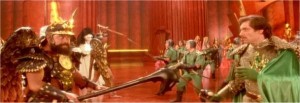 The film has an amazing cast headed up by no less an actor than Max Von Sydow as Ming the Merciless, a role he clearly relished and played to the hilt. There’s also a pre-Bond Timothy Dalton bringing a Shakespearian tenor to Prince Barin that is counterbalanced by Brian Blessed’s complete haminess as Prince Vultan of the Hawkmen. These two performances have no right whatsoever to work side-by-side, but they do. Meanwhile, Topol’s Dr. Hans Zarkov exudes all the wide-eyed excitement of a school boy on a field trip to a planetarium.
The film has an amazing cast headed up by no less an actor than Max Von Sydow as Ming the Merciless, a role he clearly relished and played to the hilt. There’s also a pre-Bond Timothy Dalton bringing a Shakespearian tenor to Prince Barin that is counterbalanced by Brian Blessed’s complete haminess as Prince Vultan of the Hawkmen. These two performances have no right whatsoever to work side-by-side, but they do. Meanwhile, Topol’s Dr. Hans Zarkov exudes all the wide-eyed excitement of a school boy on a field trip to a planetarium.
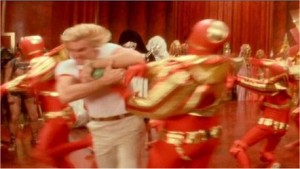 I’ve never been a fan of camp, but Flash Gordon walks that fine line between camp and more straight-forward adventure, never letting either overtake the tone of the movie. Flash Gordon is a film that never forgets its roots in the adventure comic strips and action-packed pulp magazines of the 1930s and 40s, whether it has Flash facing the poisonous beast living inside the stump in the Arborian Temple or the perilous duel with whips between Flash and Barin where one false step could send them hurtling into the void. The film even becomes a pirate movie when Vultan’s Hawkmen swoop down on the War Rocket Ajax, which first fires its lasers in broadside barrages before its captain instructs his crew to “Repel boarders!” Sure the football bit in Ming’s throne room is goofy in the extreme, but it never gets goofy enough to be cringe-inducing. Instead, the scene strikes a fine balance that stands out in stark relief to the grimness of the dungeon and execution scenes that follow. And there’s something definitely creepy and not campy about the scene where Dr. Zarkov’s memories are supposedly drained out of his brain.
I’ve never been a fan of camp, but Flash Gordon walks that fine line between camp and more straight-forward adventure, never letting either overtake the tone of the movie. Flash Gordon is a film that never forgets its roots in the adventure comic strips and action-packed pulp magazines of the 1930s and 40s, whether it has Flash facing the poisonous beast living inside the stump in the Arborian Temple or the perilous duel with whips between Flash and Barin where one false step could send them hurtling into the void. The film even becomes a pirate movie when Vultan’s Hawkmen swoop down on the War Rocket Ajax, which first fires its lasers in broadside barrages before its captain instructs his crew to “Repel boarders!” Sure the football bit in Ming’s throne room is goofy in the extreme, but it never gets goofy enough to be cringe-inducing. Instead, the scene strikes a fine balance that stands out in stark relief to the grimness of the dungeon and execution scenes that follow. And there’s something definitely creepy and not campy about the scene where Dr. Zarkov’s memories are supposedly drained out of his brain.
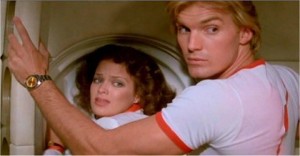 Of course, the film isn’t perfect. Jones’ Gordon and Melody Anderson’s Dale Arden are not particularly well-developed in the script, especially in relation to Flash’s fantastic surroundings, and at times they seems to be struggling to bring some depth to their characters. Additionally, it has always bugged me that even though Dr. Zarkov has forced them onto a rocketship at gunpoint and essentially kidnapped them to Mongo, they’re absolutely chummy with him for the rest of the film.
Of course, the film isn’t perfect. Jones’ Gordon and Melody Anderson’s Dale Arden are not particularly well-developed in the script, especially in relation to Flash’s fantastic surroundings, and at times they seems to be struggling to bring some depth to their characters. Additionally, it has always bugged me that even though Dr. Zarkov has forced them onto a rocketship at gunpoint and essentially kidnapped them to Mongo, they’re absolutely chummy with him for the rest of the film.
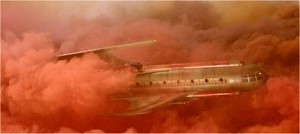 Flash Gordon’s recreation of Saturday matinee thrills predates the release of another film that owed much to the chaptered adventure serials- Raiders Of The Lost Ark. But why did critics only greet Flash lukewarmly at best but embrace the slightly more realistic and gritty atmosphere Spielberg imparted? (Coincidentally, both films shared character actor William Hootkins in small supporting roles.) Perhaps it was another space opera, George Lucas’ Star Wars (1976) with its breathtakingly real special effects technology, that spoiled critics for the simpler pleasures of some of Flash Gordon’s more primitively created visuals. While there was plenty of use of current optical compositing technology to create the fantastic worlds of Mongo, the movie also relied on shooting models on miniature sets in just the same method that the visuals were created for the original 1930s Flash Gordon serials. But for all the good visuals that optical printing could create, no amount of visual compositing could produce such an image as War Rocket Ajax moving through the psychedelic cloudscape of Mongo.
Flash Gordon’s recreation of Saturday matinee thrills predates the release of another film that owed much to the chaptered adventure serials- Raiders Of The Lost Ark. But why did critics only greet Flash lukewarmly at best but embrace the slightly more realistic and gritty atmosphere Spielberg imparted? (Coincidentally, both films shared character actor William Hootkins in small supporting roles.) Perhaps it was another space opera, George Lucas’ Star Wars (1976) with its breathtakingly real special effects technology, that spoiled critics for the simpler pleasures of some of Flash Gordon’s more primitively created visuals. While there was plenty of use of current optical compositing technology to create the fantastic worlds of Mongo, the movie also relied on shooting models on miniature sets in just the same method that the visuals were created for the original 1930s Flash Gordon serials. But for all the good visuals that optical printing could create, no amount of visual compositing could produce such an image as War Rocket Ajax moving through the psychedelic cloudscape of Mongo.




